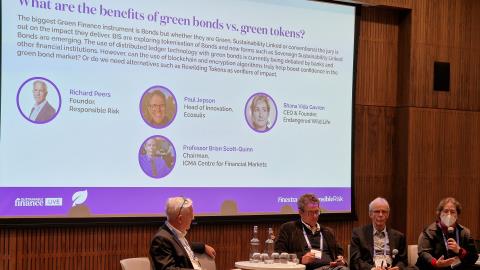How are various financial institutions tackling climate strategy and sustainable investment? This topic was addressed in the keynote presentation titled “How can nature be made bankable?” by Richard Peers, founder of ResponsibleRisk, and Philippe Zaouati, CEO of sustainable investment firm Mirova.
Zaouati emphasized that “climate and nature are two sides of the same coin.” Many large companies across industries are becoming aware of their dependencies on nature. However, understanding these dependencies is only a first step; they require accurate information to make informed decisions moving forward.
He outlined three key pillars that serve as a roadmap for companies’ impacts on nature: engaging in biodiversity, supporting the biodiversity market, and, crucially, investing in nature-based solutions. As a case in point, he mentioned Iceberg Data Lab, a French fintech company that has pioneered the data necessary to report businesses’ impacts on nature.
Zaouati pointed out that investment into economic entities aimed at restoration can significantly contribute to sustainable development. He highlighted the successful Sustainable Ocean Fund, which focuses on nature-based projects in Latin America to restore ecosystems and combat deforestation.
Concluding his session, Zaouati stated, “Utilizing land and labels for restoration, tree planting, supporting local communities through partnerships with NGOs and farmers, along with innovative co-investments, will generate long-term impacts as part of a comprehensive investment strategy.”
The largest instrument in green finance remains the bond. However, questions linger regarding the effectiveness of various types—green, sustainability-linked, or conventional.
At the Sustainable Finance Live event, discussions centered on the potential for bond tokenization and the emergence of innovative structures like sovereign sustainability-linked bonds. The use of distributed ledger technology in finance is under consideration, with questions raised about whether blockchain could enhance confidence in green bonds or if alternative methods, like rewilding tokens, could verify impact.
A panel discussion led by Richard Peers included Shana Vida Gavron, CEO of Endangered Wild.Life; Paul Jepson, head of innovation at Ecosulis; and Professor Brian Scott-Quinn, chairman of the ICMA Centre for Financial Markets. They examined the relationship between green bonds and green tokens, emphasizing that they are not competitors but rather part of a broader sustainable finance landscape. Peers posed the question of whether both could be beneficial, as bond instruments currently stand as the largest sources of finance for sustainability initiatives.
The panel discussed the rise of sustainability-linked bonds, which provide added credibility but come at a higher cost. They debated the concept of capitalizing nature and the implications of pricing it, with Gavron suggesting a distinction between pricing nature and valuing it. She expressed the risk that assigning a price might encourage destruction while a lack of valuation could lead to complacency towards biodiversity.
Gavron stated, “Acknowledging that nature is central to our survival is crucial. Everybody interacts with nature, and failing to recognize its value ignores a vital part of our planet. We must find ways to evaluate nature as we do corporations.”
However, challenges remain in valuing and managing nature’s contributions and making ecological recovery investable. Jepson highlighted a significant shift from merely protecting nature from human exploitation to recognizing the investment opportunities in nature recovery and restoration.
He described the Ecosulis digital asset—a nature impact token based on recovery metrics, similar to shares in a company. Scott-Quinn echoed the need for consideration of energy transitions in funding and noted that ultimately, all bonds and loans should be green to align with sustainability objectives.
He also stressed that while blockchain and distributed ledger technology could support transparency, they are not silver bullets for the existing challenges, including the prevalence of greenwashing. The effectiveness of achieving meaningful change hinges on holding company directors accountable for misleading claims about sustainability.
In her presentation, Gina Belle, CEO of the Chora Foundation, explored use cases for driving environmental and social change through sustainable strategies in both public and private sectors. She pointed out that transformative actions in sustainable finance are becoming increasingly complex and outlined a three-tiered model for addressing challenges in this area.
Belle’s framework includes capital allocation, strategic innovation, and managing uncertainty. She emphasized the importance of leveraging financial services to address evolving risks and challenges, highlighting the need for collaboration across organizations to develop shared intentions and foster informal connections.
Using sustainable tourism in Egypt as a case study, she demonstrated how Chora employs the Social System Transformation Canvas to navigate complex challenges and align various strategies toward sustainable outcomes. Belle posed thought-provoking questions about responsibility for investing in the future of sustainability and resilience of broader systems, ultimately challenging attendees to embrace collaboration and transformative investments.
She concluded with a powerful statement: “You cannot stay the same and transform at the same time.”
